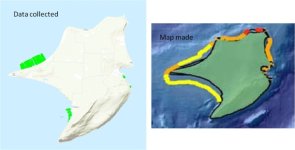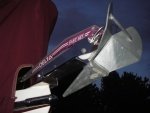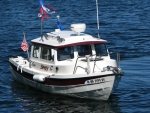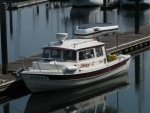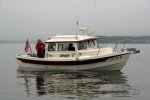After spending most of a day and several pieces of the night, going back over the Anchor forum back to Oct of 2003, and searching under Rocna, Manson (Supreme) and Delta, Fast Set, CQR, and Bruce and as many other variations as I could think of, I found some very interesting information.
Going back in time, the original new and best was the Bruce, (a splayed flange type called a claw), followed in a few years by the Delta, (a plow version), and recently a popular trend is the Manson Supreme or another version of a spade, the Rocna, which has a roll bar.
There is usually some consideration given to the geographical location of use, and from that, some deference to substrate is assumed.
There is often discussion about the rollers, swivel or not, and much about the windless, (sometimes called wench or winch).
The bottom vegetation, or lack of, is also mentioned as having an effect on the gripping and holding capability.
Being somewhat logical, and some a believer in physics, and having spent some time in my early youth, farming, I have some anchor observations:
1. The shape of the anchor has a lot to do with how well it works.
2. Different anchors work better in different situations – i.e., bottom make-up.
3. Any substrate is likely to hold better when compacted rather than dispersed or divided.
4. Any anchor will probably work better when coupled with some chain. The chain length adds weight to hold the anchor down, applying the force parallel with the substrate surface.
5. Using an anchor that is working (popular and used) in an area is not a bad idea.
So let’s talk shapes a bit.
1. Flukes, dig in an hold, deeper depending on the angle. (Fortress or Danforth)
2. Claw, lighter than plow, can turn without losing “set”. (Bruce)
3. Plow, good holding on various bottoms, rapidly digs in for “set”. (Delta)
4. Spade, lighter than claw or plow, shaped to compact substrate under tension. (Rocna or Manson)
5. There are others, mushroom, grapnel, and kedge.
• From: http://www.boatus.org/guide/navigation_31.html
Not being an expert anchorer, and in truth, not anchoring very much, but now looking at more opportunity for doing just that, I am doing some research in that field, in preparation for some field practice. In doing that a ran across…….. guess what…….. YUP, a new anchor.
Made by the same manufacturer as the “Rocna”, which looks like a Delta shaft on a spade blade, with a roll bar, the Rocna has found fair acceptance in the new anchor swing. (A similar style, the Manson Supreme appears to have had more success, at least in the C-Brat arena) and both are using the spade blade instead of the plow.)
Is the thought pendulum swinging? Or are the physics just now getting through and we are catching up?
The Rocna manufacturer is now producing a second version, sans roll bar, wider spade and different shaped (more rounded curve on the shaft) anchor called the “Vulcan”. I saw it at the SBS and have been reading what I could about it. Wonder if anyone else noticed it, and what your thoughts were?
Harvey
SleepyC:moon
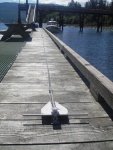
Going back in time, the original new and best was the Bruce, (a splayed flange type called a claw), followed in a few years by the Delta, (a plow version), and recently a popular trend is the Manson Supreme or another version of a spade, the Rocna, which has a roll bar.
There is usually some consideration given to the geographical location of use, and from that, some deference to substrate is assumed.
There is often discussion about the rollers, swivel or not, and much about the windless, (sometimes called wench or winch).
The bottom vegetation, or lack of, is also mentioned as having an effect on the gripping and holding capability.
Being somewhat logical, and some a believer in physics, and having spent some time in my early youth, farming, I have some anchor observations:
1. The shape of the anchor has a lot to do with how well it works.
2. Different anchors work better in different situations – i.e., bottom make-up.
3. Any substrate is likely to hold better when compacted rather than dispersed or divided.
4. Any anchor will probably work better when coupled with some chain. The chain length adds weight to hold the anchor down, applying the force parallel with the substrate surface.
5. Using an anchor that is working (popular and used) in an area is not a bad idea.
So let’s talk shapes a bit.
1. Flukes, dig in an hold, deeper depending on the angle. (Fortress or Danforth)
2. Claw, lighter than plow, can turn without losing “set”. (Bruce)
3. Plow, good holding on various bottoms, rapidly digs in for “set”. (Delta)
4. Spade, lighter than claw or plow, shaped to compact substrate under tension. (Rocna or Manson)
5. There are others, mushroom, grapnel, and kedge.
• From: http://www.boatus.org/guide/navigation_31.html
Not being an expert anchorer, and in truth, not anchoring very much, but now looking at more opportunity for doing just that, I am doing some research in that field, in preparation for some field practice. In doing that a ran across…….. guess what…….. YUP, a new anchor.
Made by the same manufacturer as the “Rocna”, which looks like a Delta shaft on a spade blade, with a roll bar, the Rocna has found fair acceptance in the new anchor swing. (A similar style, the Manson Supreme appears to have had more success, at least in the C-Brat arena) and both are using the spade blade instead of the plow.)
Is the thought pendulum swinging? Or are the physics just now getting through and we are catching up?
The Rocna manufacturer is now producing a second version, sans roll bar, wider spade and different shaped (more rounded curve on the shaft) anchor called the “Vulcan”. I saw it at the SBS and have been reading what I could about it. Wonder if anyone else noticed it, and what your thoughts were?
Harvey
SleepyC:moon


